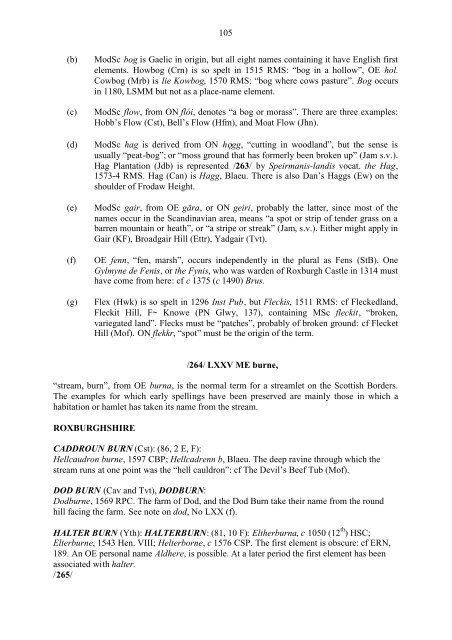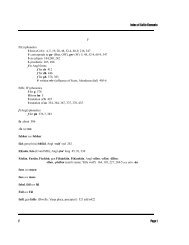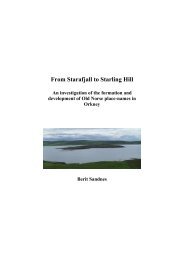May Williamson: The Non-Celtic Place-Names of the Scottish Border ...
May Williamson: The Non-Celtic Place-Names of the Scottish Border ...
May Williamson: The Non-Celtic Place-Names of the Scottish Border ...
You also want an ePaper? Increase the reach of your titles
YUMPU automatically turns print PDFs into web optimized ePapers that Google loves.
105<br />
(b)<br />
(c)<br />
(d)<br />
(e)<br />
(f)<br />
(g)<br />
ModSc bog is Gaelic in origin, but all eight names containing it have English first<br />
elements. Howbog (Crn) is so spelt in 1515 RMS: “bog in a hollow”, OE hol.<br />
Cowbog (Mrb) is lie Kowbog, 1570 RMS: “bog where cows pasture”. Bog occurs<br />
in 1180, LSMM but not as a place-name element.<br />
ModSc flow, from ON flói, denotes “a bog or morass”. <strong>The</strong>re are three examples:<br />
Hobb’s Flow (Cst), Bell’s Flow (Hfm), and Moat Flow (Jhn).<br />
ModSc hag is derived from ON hgg, “cutting in woodland”, but <strong>the</strong> sense is<br />
usually “peat-bog”; or “moss ground that has formerly been broken up” (Jam s.v.).<br />
Hag Plantation (Jdb) is represented /263/ by Speirmanis-landis vocat. <strong>the</strong> Hag,<br />
1573-4 RMS. Hag (Can) is Hagg, Blaeu. <strong>The</strong>re is also Dan’s Haggs (Ew) on <strong>the</strong><br />
shoulder <strong>of</strong> Frodaw Height.<br />
ModSc gair, from OE gāra, or ON geiri, probably <strong>the</strong> latter, since most <strong>of</strong> <strong>the</strong><br />
names occur in <strong>the</strong> Scandinavian area, means “a spot or strip <strong>of</strong> tender grass on a<br />
barren mountain or heath”, or “a stripe or streak” (Jam, s.v.). Ei<strong>the</strong>r might apply in<br />
Gair (KF), Broadgair Hill (Ettr), Yadgair (Tvt).<br />
OE fenn, “fen, marsh”, occurs independently in <strong>the</strong> plural as Fens (StB). One<br />
Gylmyne de Fenis, or <strong>the</strong> Fynis, who was warden <strong>of</strong> Roxburgh Castle in 1314 must<br />
have come from here: cf c 1375 (c 1490) Brus.<br />
Flex (Hwk) is so spelt in 1296 Inst Pub, but Fleckis, 1511 RMS: cf Fleckedland,<br />
Fleckit Hill, F~ Knowe (PN Glwy, 137), containing MSc fleckit, “broken,<br />
variegated land”. Flecks must be “patches”, probably <strong>of</strong> broken ground: cf Flecket<br />
Hill (M<strong>of</strong>). ON flekkr, “spot” must be <strong>the</strong> origin <strong>of</strong> <strong>the</strong> term.<br />
/264/ LXXV ME burne,<br />
“stream, burn”, from OE burna, is <strong>the</strong> normal term for a streamlet on <strong>the</strong> <strong>Scottish</strong> <strong>Border</strong>s.<br />
<strong>The</strong> examples for which early spellings have been preserved are mainly those in which a<br />
habitation or hamlet has taken its name from <strong>the</strong> stream.<br />
ROXBURGHSHIRE<br />
CADDROUN BURN (Cst): (86, 2 E, F):<br />
Hellcaudron burne, 1597 CBP; Hellcadrenn b, Blaeu. <strong>The</strong> deep ravine through which <strong>the</strong><br />
stream runs at one point was <strong>the</strong> “hell cauldron”: cf <strong>The</strong> Devil’s Beef Tub (M<strong>of</strong>).<br />
DOD BURN (Cav and Tvt), DODBURN:<br />
Dodburne, 1569 RPC. <strong>The</strong> farm <strong>of</strong> Dod, and <strong>the</strong> Dod Burn take <strong>the</strong>ir name from <strong>the</strong> round<br />
hill facing <strong>the</strong> farm. See note on dod, No LXX (f).<br />
HALTER BURN (Yth): HALTERBURN: (81, 10 F): El<strong>the</strong>rburna, c 1050 (12 th ) HSC;<br />
Elterburne, 1543 Hen. VIII; Helterborne, c 1576 CSP. <strong>The</strong> first element is obscure: cf ERN,<br />
189. An OE personal name Aldhere, is possible. At a later period <strong>the</strong> first element has been<br />
associated with halter.<br />
/265/




